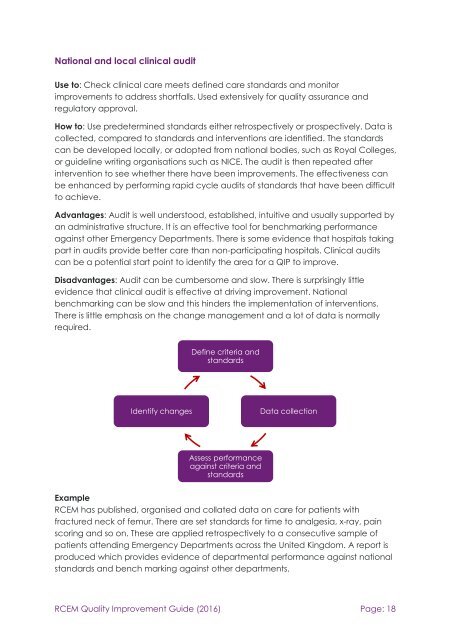RCEM QUALITY IMPROVEMENT GUIDE
2fvpeHu
2fvpeHu
You also want an ePaper? Increase the reach of your titles
YUMPU automatically turns print PDFs into web optimized ePapers that Google loves.
National and local clinical audit<br />
Use to: Check clinical care meets defined care standards and monitor<br />
improvements to address shortfalls. Used extensively for quality assurance and<br />
regulatory approval.<br />
How to: Use predetermined standards either retrospectively or prospectively. Data is<br />
collected, compared to standards and interventions are identified. The standards<br />
can be developed locally, or adopted from national bodies, such as Royal Colleges,<br />
or guideline writing organisations such as NICE. The audit is then repeated after<br />
intervention to see whether there have been improvements. The effectiveness can<br />
be enhanced by performing rapid cycle audits of standards that have been difficult<br />
to achieve.<br />
Advantages: Audit is well understood, established, intuitive and usually supported by<br />
an administrative structure. It is an effective tool for benchmarking performance<br />
against other Emergency Departments. There is some evidence that hospitals taking<br />
part in audits provide better care than non-participating hospitals. Clinical audits<br />
can be a potential start point to identify the area for a QIP to improve.<br />
Disadvantages: Audit can be cumbersome and slow. There is surprisingly little<br />
evidence that clinical audit is effective at driving improvement. National<br />
benchmarking can be slow and this hinders the implementation of interventions.<br />
There is little emphasis on the change management and a lot of data is normally<br />
required.<br />
Define criteria and<br />
standards<br />
Identify changes<br />
Data collection<br />
Assess performance<br />
against criteria and<br />
standards<br />
Example<br />
<strong>RCEM</strong> has published, organised and collated data on care for patients with<br />
fractured neck of femur. There are set standards for time to analgesia, x-ray, pain<br />
scoring and so on. These are applied retrospectively to a consecutive sample of<br />
patients attending Emergency Departments across the United Kingdom. A report is<br />
produced which provides evidence of departmental performance against national<br />
standards and bench marking against other departments.<br />
<strong>RCEM</strong> Quality Improvement Guide (2016) Page: 18


